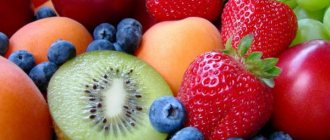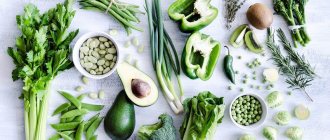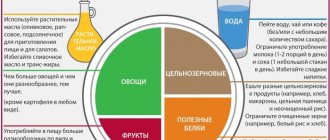It is no secret that proper and balanced nutrition is the key to good health, however, unfortunately, not all people follow this rule. The number of people who suffer from gastrointestinal diseases increases every year; diseases affect patients younger and younger.
A special diet is required for gastrointestinal ailments that spares internal organs. However, this does not oblige people with similar ailments to use only liquid gruel, which will not cause harm. You need to know how to prepare healthy foods, how to balance your diet, and what you need to completely avoid.
Beef soup
Since it is not recommended to add fatty meats with the diseases discussed to your menu, you should prepare your lunch from lean beef. For example, cream soup. Using the same recipe you can make a dish for their chicken/turkey.
Preparation next.
Composition of ingredients
For the dish you need to take:
- lean beef – 770-800 g;
- potatoes – 8-9 pcs.;
- butter fat – 90-100 g;
- eggs – 4 pcs.;
- low-fat cream - 1 bottle;
- salt.
Spices should not be added to such a treat. It will already have a bright, pleasant taste.
Step-by-step cooking process
The cooking process includes several stages:
- Lean beef must be filled with water and cooked until fully cooked. During the process, be sure to remove foam from the surface of the liquid. It is advisable to strain the broth through several layers of clean gauze. Then it will turn out especially appetizing and transparent.
- Potatoes need to be washed with running water, peeled, filled with water and cooked until soft and fully cooked in a separate bowl. While still hot, you will need to rub the product through a sieve. You will get a homogeneous, tender vegetable mass.
- Afterwards, the potatoes should be diluted with the broth from the first step.
- All that remains is to boil the mixture for a couple of minutes, add the yolks of raw eggs, and dilute with cream.
- After adding the dairy product, you will have to heat the soup.
Then you can serve the dish to the table. Before pouring into plates, the treat is seasoned with salt to taste.
What can I add?
A small amount of small pasta can also be added to this soup. For example, a handful of noodles. This ingredient will additionally add satiety to the dish.
How to serve a dish
If you plan to serve the treat with bread, then it is best to choose dried pieces. Only wheat lean buns will do. It is not recommended to eat rye bread if you have gastrointestinal problems.
Diet for a sick stomach?
The mucous membrane of this digestive organ, affected by one or another disease, requires special gentle care with the inclusion in the diet of foods containing a high concentration of fiber and a low level of organic acids. The latter substances contribute to irritation of the walls of the stomach, which only increases the feeling of pain. Based on this, gastroenterologists divided foods and dishes into two separate categories. Some recommend eating them daily and they will not cause any harm to the gastrointestinal tract, while others are strictly contraindicated.
What can you eat if your stomach hurts?
For patients suffering from severe pain in the stomach, nutritionists and gastroenterologists recommend saturating their menu with the following dishes and products:
- cereal porridges from cereals such as buckwheat, wheat, barley, pearl barley, semolina, corn, boiled to a jelly state (they can be cooked with water or milk, but with minimal fat content);
- boiled chicken meat, cut from the breast (it can be cooked in the traditional way in a saucepan, or cooked in a steam bath);
- oven-baked pumpkin (this dish not only relieves inflammation of the gastric mucosa, but also improves appetite, accelerates the flow of bile, which is very important for patients with low acidity);
- fermented milk products with a fat content not exceeding 1.5% (sour cream, kefir, fermented baked milk, curdled milk, yogurt);
- salads of fresh cucumbers, cabbage, seasoned with a small amount of sunflower or olive oil (the addition of dill, parsley, celery is welcome);
- boiled chicken eggs (this product is allowed to be consumed only in boiled form and it is strictly contraindicated to eat fried eggs, as the stomach will hurt even more);
- vegetable soups without fried onions and meat products (they are very quickly absorbed by the inflamed tissues of the digestive organ and at the same time contain all the necessary vitamins and minerals);
- non-fat chicken broths, which are cooked with the addition of a small amount of salt;
- pasta made from durum wheat (this type of product is perfectly absorbed by the body and at the same time does not put much strain on the stomach);
- only white bread made from premium flour, which does not contain acids and provides the sick person’s body with a sufficient amount of complex carbohydrates.
The main motto of proper nutrition for a sick stomach is to include in your menu the most healthy, nutritious dishes that are at the same time easily digestible by the gastrointestinal tract. The emphasis should be on cereal porridges and vegetable soups . The main thing is not to allow long intervals between meals. Meals should be frequent (about 5-6 times a day), but in small portions.
What should you not eat?
Dishes that, due to their biochemical composition, have the effect of irritating the mucous membrane are strictly prohibited. These include the following food products:
- tomatoes, tomato juice and paste prepared on the basis of this sour vegetable (it contains an increased concentration of organic acids, so after eating it there will be increased pain inside the stomach);
- all types of citrus fruits, regardless of how they are prepared, eaten raw, or processed into fruit drinks, juices;
- fried, salted, smoked, pickled dishes (even if they contain products that were initially allowed from a dietary point of view, but their method of preparation neutralized the original biological value);
- canned vegetables and fruits that have been sealed according to a recipe that calls for the addition of vinegar, large amounts of salt, citric acid or sugar;
- cottage cheese, cream, hard cheese (despite all the benefits of these foods and their biological value, they are too heavy for the stomach, take a long time to digest and, in addition, can provoke an increase in the concentration of hydrochloric acid in the gastric juice);
- fatty meats and bacon (pork, lamb, duck should not be in the diet);
- gray bread (due to the high level of acidity), as well as confectionery products that contain palm fat, emulsifiers and preservatives;
- mushrooms of all types and methods of preparation (this product is practically not absorbed even by a healthy digestive system, and mushrooms are completely contraindicated for people with stomach problems, since they will not bring a person anything other than a feeling of severe pain);
- peas, lentils, beans, soybeans and other types of legumes.
Depending on the type of stomach disease detected, the form of the pain syndrome, a nutritionist or gastroenterologist may recommend that the patient exclude other types of food products if limiting their intake will help the patient get rid of both the pain syndrome and the current disease.
Sample menu
In order to know exactly what dishes to eat during the current day, you should create a meal schedule and write down breakfast, lunch and dinner in detail. To this end, it is recommended to organize your menu as follows:
| Day of the week | Breakfast | Dinner | Dinner |
| Monday | Vegetable soup with the addition of a small amount of cereals, a bun baked from premium flour with compote | Pasta with a piece of chicken, boiled in water or steamed | Chicken broth with white bread, a piece of oven-baked pumpkin |
| Tuesday | Buckwheat porridge seasoned with a little butter, yogurt | A serving of pasta and fresh cabbage salad mixed with sunflower or olive oil | Milk jelly, sweet bun or diet cookies “Maria” |
| Wednesday | Low-fat broth made from rabbit, chicken or young veal meat, white bread | Wheat porridge in water, boiled until semi-liquid | Vermicelli with a piece of chicken (100-150 grams) and fresh cucumber salad with herbs |
| Thursday | Vegetable soup (with or without added grains) | Oatmeal with butter, yogurt with bun | Chicken broth with 1 boiled egg and white bread |
| Friday | Barley porridge with a piece of boiled chicken, a glass of rosehip compote | Pasta with cabbage salad, fruit or berry jelly | Vegetable soup, a piece of white bread, weak tea |
| Saturday | Mashed potatoes prepared exclusively with water, salad of fresh cucumbers and herbs | Semolina porridge cooked in milk with a fat content of no more than 1% | Vermicelli with a piece of chicken and fresh cabbage salad |
| Sunday | Chicken broth, one boiled egg, milk jelly | Rice porridge, chicken, cucumber and herb salad | Vegetable soup with white bread, dried fruit compote with bun |
Each person suffering from stomach pain can independently determine exactly how to formulate their menu so that it matches their gastronomic preferences and at the same time does not aggravate the painful condition of the digestive system organ.
Similar articles:
Fish cream soup
Dietary dishes for gastrointestinal diseases are also prepared from fish. For example, a delicate cream soup. It is best to take low-fat river fish for a treat.
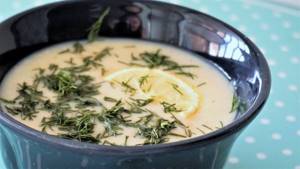
Carp, chum salmon, pike perch, and smelt are suitable for it. The calorie content of the finished dish will be approximately 45 kcal per 100 g.
And his BJU:
| BJU | Value in g (per 100 g) |
| Squirrels | 3,8 |
| Fats | 2,4 |
| Carbohydrates | 1,3 |
Composition of ingredients
For the dish you need to take:
- river fish – 750-800 g;
- flour (sifted) – 1.5-2 tbsp. l.;
- carrots and parsley - 1 pc.;
- onions – 2 pcs.;
- oil, salt.
Step-by-step cooking process
The cooking process includes several stages:
- Raw fish must be cleaned and then rinsed thoroughly. Be sure to separate the meat from the bones. You should get a clean fillet. But the bones should not be thrown away. The broth will be cooked on them.
- You will need to place the fish bones with roots into a saucepan and add water. The base of the soup will take about half an hour to cook.
- The remaining fish pulp must be cut into small pieces. They will be stewed in oil with onions. The latter must first be cleaned, washed, and finely chopped.
- Separately, in a saucepan you need to fry the flour with a couple of tablespoons of any vegetable oil until creamy. The mass should be diluted with 4 tbsp. broth strained from bones and roots.
- Cook the treat for another 17-20 minutes.
- The finished soup must be strained and rubbed through a sieve. Then dilute with hot milk, season with salt and butter.
If desired, you can add raw egg yolks, lightly beaten with milk, into the treat.
How to serve a dish
Serve the soup with pieces of fish. You can also make meatballs from the latter. It’s delicious to serve croutons separately. You can serve the soup with pieces of fish or meatballs.
Diet
The most important part of the diet is adherence to nutritional culture. To do this you need:
1. Set fixed times for meals.
2. Increase meals and reduce single portions. To prevent stomach diseases, three meals a day are needed; in a diet for chronic diseases, four meals a day are used; six months after an exacerbation, five meals a day; after 3 weeks, six meals a day.
3. Separate drinking chilled liquids or food (milk, juice, drinks, water, ice cream) from eating solid food with plenty of protein and crude carbohydrates with a 2-3 hour break. If you have established stomach diseases, it is better to avoid them altogether. During exacerbations, you should not eat food colder than 15 °C.
4. Avoid hot foods or drinks. The maximum permissible temperature, including cooling in the mouth, is 65 °C.
5. Chew food thoroughly and do not swallow it abruptly. In the diet of patients, crushed food is used, after an exacerbation - grated or even through a sieve.
If you have stomach pain, you can eat:
- porridge, boiled into a semi-liquid state and rubbed through a sieve - semolina, rice, buckwheat, oatmeal. It is better to cook porridge with milk, without adding salt and butter;
- vermicelli, pasta;
- soups – cereal, slimy, with vegetable broth;
- bread - white, yesterday's bread, dried in the oven, or white dry crackers;
- soft-boiled egg or steamed omelette;
- vegetables boiled and crushed to a puree - potatoes, carrots, beets, pumpkin, zucchini, cauliflower;
- boiled meat and low-fat fish - chopped into cutlets, purees and other dishes;
- rosehip decoction and weak tea.
If you have stomach pain, you should absolutely not eat:
- fatty meat and fish;
- spicy, salty dishes, sauces and seasonings;
- breaded fried foods;
- vegetables with an abundance of coarse fiber - white cabbage, radishes, radishes, onions and so on, especially raw;
- eggs hard-boiled or fried to form a rough, burnt crust;
- all animal fats and margarines, except high quality butter (including ghee);
- smoked products and canned food prepared using smoking or frying, that is, everything except dietary ones;
- undried black bread and baked goods;
- alcohol in any form.
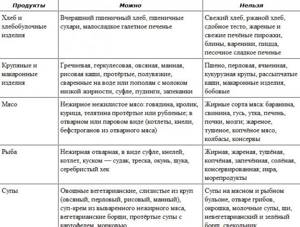
Additional dietary recommendations and prohibitions depend on the symptoms accompanying the disease and diagnosis:
1. Watery diarrhea and pain in the stomach and intestines, gurgling in the stomach, vomiting are signs of food poisoning or bacterial infection.
2. Abdominal pain above the navel, nausea, heartburn, belching, diarrhea - gastritis with high acidity.
3. If the pain is accompanied by constant heaviness in the stomach, putrid belching and bad breath, diarrhea or constipation, this is a sign of gastritis with low acidity.
4. When your stomach hurts severely after eating or in the morning on an empty stomach, is accompanied by vomiting, constipation, or there is blood in the discharge, you should immediately consult a doctor. At best, these are symptoms of hemorrhagic or erosive gastritis, but most likely - gastric or duodenal ulcers.
5. If you feel sick, have severe pain in the pancreas (pain in the area just to the left of the stomach, radiates to the back), diarrhea with obvious remains of undigested food in the stool, there is bitterness and a whitish coating in the mouth - you need to call an ambulance. Pancreatitis during an exacerbation is a fatal disease, which also quickly leads to complications.
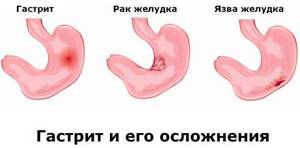
Meat zrazy with filling
This meaty treat will be a hearty main course for lunch or dinner. All that remains is to choose the right side dish for it. It should also be light and harmless.
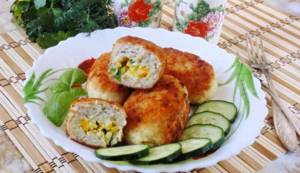
For example, stewed vegetables, tender mashed potatoes, steamed broccoli. The special feature of this dish is the omelette filling.
Composition of ingredients
For the dish you need to take:
- beef tenderloin – 140-150 g;
- white bread (stale) – 25-30 g;
- milk – 15-20 ml;
- butter – 1-15 g;
- egg – ½ pcs.;
- salt.
Step-by-step cooking process
The cooking process includes several stages:
- The contents of the raw egg should be placed in a small bowl. Then whisk together with non-hot milk.
- The resulting mass in the last step must be poured into a frying pan with a minimum amount of oil. It is enough to simply treat the surface of the dishes with a silicone brush dipped in vegetable fat.
- Bake the contents of the pan in a frying pan over low heat with the lid closed. The finished omelette must be cooled and chopped into pieces.
- Washed fresh beef (flesh) will need to be minced at least 2 times. Together with the meat, it should be processed immediately with bread, previously soaked in milk and squeezed out of excess liquid. For a meat grinder, it is recommended to choose a nozzle with a fine grid.
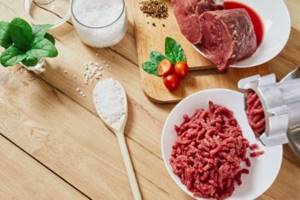
- From the resulting meat mass you need to form 2 round-sized cakes. You need to place an omelette in the middle of each and securely pinch the edges of the workpieces.
The resulting meat cakes with filling should be placed on a wire rack and steamed. It is convenient to do this in a slow cooker.
How to serve a dish
You should try the finished dish warm or hot. It is worth pouring the remaining oil over it. Milk sauce also complements the treat well.
Rice roll with fruit
Dietary dishes for gastrointestinal diseases may well be sweet. Desserts are not completely prohibited for such health problems. You just need to cook them correctly. You can use any fruit for the recipe. It is best to combine them with dried fruits. The more additives there are, the tastier the treat will be.
Composition of ingredients
For the dish you need to take:
- rice – 45-50 g;
- milk – ½ tbsp.;
- butter – 20-25 g;
- sugar – 1 tbsp. l.;
- egg – ½ pcs.;
- apple – 45-50 g;
- prunes and raisins – 15-20 g each;
- water – 50 ml.
The amount of sugar may at first glance seem insufficient. But you shouldn't increase it. The addition of dried fruits compensates for the small portion of sand.
Step-by-step cooking process
The cooking process includes several stages:
- First you need to process the cereal. The rice needs to be ground. The most convenient way to do this is in a coffee grinder.
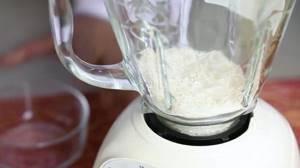
- Afterwards, the resulting crushed cereal will need to be poured with milk, mixed well, transferred to a saucepan and brought to a boil.
- Then granulated sugar will dissolve in the mass. All that remains is to cool it.
- Beat half the egg with butter. Only after this – combine with rice porridge.
- The resulting mass must be placed on clean pharmacy gauze (it is best to take a couple of layers), soaked in boiled water. The product layer on the material should be approximately 1 cm.
- Spread all the filling ingredients on top. To do this, you will need to peel and chop the apples. By the way, fruit processing with a grater is allowed. Raisins and prunes can be finely chopped or blended in a blender.
- Then you need to wrap the workpiece with a roll.
The future dessert should be transferred to an oiled frying pan and steamed. It should ultimately keep its shape well.
How to serve a dish
Before serving, cut the roll into pieces and place it on a large flat plate. It’s delicious to try the treat, for example, with a sauce made from low-fat sour cream and fresh berries ground to a puree.
Zucchini-apple pudding
Another option for a delicious and healthy treat is pudding. Its basis is immediately vegetables and fruits. For the dish, it is best to combine zucchini and apples.

The result is a most delicate treat, which, if you increase the amount of sugar, can also be served as a dessert.
Composition of ingredients
For the dish you need to take:
- fresh zucchini – 230-250 g;
- apples (large size) – 2 pcs.;
- milk – ¼ tbsp.;
- butter – 3 tbsp. l.;
- egg yolks and whites – 2 pcs.;
- semolina and granulated sugar - 2 tbsp each. l.;
- low-fat sour cream - ½ tbsp.
Step-by-step cooking process
The cooking process includes several stages:
- Washed zucchini must be peeled. This must be done even if the vegetables are young. For old zucchini, you also need to remove the core with large seeds.
- Afterwards the vegetable needs to be chopped. Its pieces will simmer with 10 g of butter. As a result, the zucchini should be half cooked.
- Apples should also be chopped randomly and mixed with zucchini. You need to sprinkle sugar on top. After about 6 minutes of stewing, you can add semolina. All that remains is to keep the mixture in the pan under the lid on the edge of the stove for approximately 7-8 minutes.
- Then you will need to add separate beaten egg whites and yolks to the mixture.
- After mixing, you need to transfer the mass into an oiled heat-resistant form.
Bake the treat in the oven at medium temperature until firm and completely cooked.
How to serve a dish
The treat should be served slightly cooled. It’s delicious topped with sour cream. It is best to choose a dairy product with approximately 10-15% fat content.
Milk jelly
Dietary dishes are often prepared with dairy products. The delicacy according to the recipe published below in the article can be eaten for various gastrointestinal diseases.
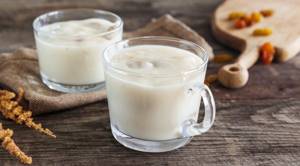
Dietary dishes for gastrointestinal diseases - milk jelly is good.
It is tender, soft, sweet. Even the smallest gourmets and those with a sweet tooth will love the treat.
Composition of ingredients
For the dish you need to take:
- milk – 4 tbsp.;
- sugar – ½ tbsp.;
- starch – 55-60 minutes;
- vanillin, lemon zest to taste.
The lemon should first be washed and dried. Then, use a fine grater to remove the zest from the citrus. You should use a little of it for the recipe. A pinch of zest will be enough for a bright, pleasant aroma of the treat. Vanillin should be added to a dish literally at the tip of a knife.
Step-by-step cooking process
The cooking process includes several stages:
- Most of the milk needs to be sent to a pre-prepared pan - 3 tbsp. The liquid must be brought until bubbles appear and boiled.
- Then you can add sand. The sweet crystals should completely dissolve in the liquid.
- Starch should be diluted in 1 tbsp. liquids. Both boiled water and cold milk (leftover) will do. You can take different starches - both potato and maize. Be sure to mix these ingredients thoroughly. It is convenient to do this with a hand whisk.
- The resulting mixture with starch must be poured into boiling milk. For flavor, you will need to add vanillin and lemon zest to the jelly. By the way, orange zest or almond essence will also work.
- After stirring and heating for a couple of minutes, you can pour the treat into cups or bowls.
When the jelly has completely hardened, you can transfer it to flat dessert plates.
How to serve a dish
It is worth decorating the delicacy with fresh berries or patterns of jam/preserve. Liquid bee/flower honey is also suitable to complement the treat.
Foods to avoid if you have a sick stomach
Recommendations on what to eat when you have stomach pain would be incomplete without a list of prohibited foods.
For a sick stomach, the following are completely excluded:
- Alcohol.
- Carbonated drinks.
- Baked goods, baked goods (for example, dried bread, dry cookies).
- Spicy seasonings, sauces.
- Canned food.
- Fatty broths.
- Sour fruits, berries, vegetables.
- Vegetables with a lot of coarse fiber (white cabbage, radish, turnip).
- Fried and smoked.
On a note
Nutrition should provide the body with all the necessary nutrients in a well-digestible form.
For this purpose, specialized food products are used for gastrointestinal diseases. Diso Nutrimun provides the body with protein of high biological value in the most digestible form. The product perfectly complements the diet of therapeutic diets, as it is added to dishes at the cooking stage.
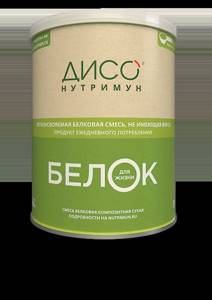
Steamed pork balls
Instead of pork cutlets, you can make delicious meat balls. It is best to use lean meat for the dish. To make the treat more spicy, you should also add shrimp paste, cashew nuts, soy sauce, and cilantro.
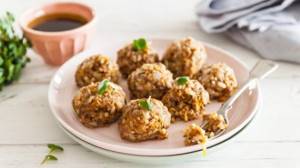
Some of the listed components may be excluded from the recipe.
Composition of ingredients
For the dish you need to take:
- lean pork - half a kilo;
- onions – 5 pcs.;
- cashew nuts and cilantro - 1 tbsp. l.;
- raw egg whites – 2 pcs.;
- coconut milk – 120-130 ml;
- sugar – 1 tsp;
- white pepper - on the tip of a knife;
- shrimp paste – 1 tsp;
- dark soy sauce – 2 tbsp. l.
Nuts need to be prepared first. To do this, you will need to lightly fry them in a dry frying pan.
Step-by-step cooking process
The cooking process includes several stages:
- You should start with meat. It must be thoroughly washed with cold running water and cut into pieces. Afterwards, pass the product through a meat grinder. The device must be equipped with a large grille.
- You can then add onions, prepared nuts, shrimp paste, and garlic to the meat. The latter will first be peeled. Then add washed cilantro, white pepper, and dark soy sauce to the mixture.
- All mixed products will need to be processed with a mixer or a suitable blender attachment. They should be crushed and slightly beaten.
- The resulting mass should be placed in a large bowl, poured with coconut milk and mixed well.
- The whites need to be beaten separately. They should turn into a stable thick foam. Only after this can the proteins be mixed into the meat mixture.
- You will need to roll several balls from the mixture. Optimally – 5-6 pieces. Each piece should be placed in a separate small bowl. Then place each one in a double boiler.
- In this form, the meat treat will simmer for about 20 minutes. You should leave it until the pork is completely cooked. Be sure to cover the containers with meat in the steamer with cling film or parchment. This is required to prevent excess moisture from getting on the balls.
The resulting dish in bowls must be removed from the steamer and the contents allowed to cool.
How to serve a dish
It is best to serve the finished treat with a sweet pepper salad. It will be quick and easy to do. You need to cut the peeled sweet pepper into pieces and mix them with soy sprouts. All that remains is to sprinkle the ingredients with fish sauce and lime juice. Bowls of meat balls should be tipped over next to the salad. Before taking the sample, each should be cut into 4 parts.
Sea bass cutlets
Dietary dishes for gastrointestinal diseases are prepared from different types of fish. The cutlets are very tasty. They should be based on sea bass.
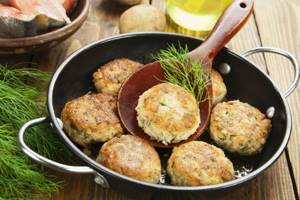
Only fillets will be used from the fish. Therefore, the product should be cleaned in advance of all excess, rinsed, and dried.
Composition of ingredients
For the dish you need to take:
- sea bass fillet – 370-400 g;
- loaf (with pre-cut crusts) – 80-100 g;
- egg – 1 pc.;
- butter fat (melted) – 2 tbsp. l.;
- salt.
Step-by-step cooking process
The cooking process includes several stages:
- Only fish fillets will be used in the dish; all other parts can be discarded. It must be washed, dried, and passed through a meat grinder. Immediately with the fish, you need to process the bread soaked in water and squeezed out of excess liquid.
- The resulting minced meat must be thoroughly mixed and salted to your taste. It is not recommended to add spices to it.
- Separately, you need to lightly beat the egg and pour it into the fish mixture. After the next stirring, beat the product on the table or directly in the bowl.
- Then you will need to form neat small cutlets (breading will not be used). They need to be placed on the steamer rack in strictly one layer. The entire structure should be installed over a pan of boiling water. The treat will take about a quarter of an hour to prepare. The exact time depends on the size of the cutlets. If necessary, you can add a few more minutes.
Slightly cooled cutlets can be served immediately.
How to serve a dish
When serving, the dish should be placed on portioned plates and complemented with any side dish. For example, steamed potatoes are perfect for this. If it is accompanied by a sauce, it is better to choose a sauce made from milk or based on low-fat sour cream without hot spices.
Diet for gastrointestinal diseases: recommendations
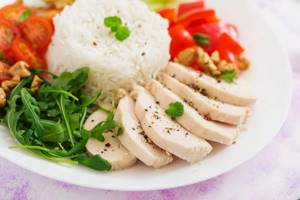
- It is better to boil, stew or bake food products; frying should be avoided;
- to create dishes, take lean meat from young animals; fresh frozen lean fish;
- fatty meat and sausages are prohibited;
- cooking should be carried out in a frying pan coated with Teflon and without adding fat, since under the influence of high temperatures it “burns”, and the toxic substances released during this process cause irritation of the gastric mucosa;
- You should avoid solid foods, large pieces, fruits with skin, cartilage, tendons, as they have a bad effect on digestion;
- you can season already created dishes with oils;
- food and drink should be moderately warm (ice cold drinks and boiling water should be avoided);
- a diet for gastrointestinal diseases requires giving up natural coffee powder, cocoa powder, sweetened water, alcohol-containing drinks and very chilled drinks;
- the products must be thoroughly boiled/stewed/baked; salts and seasonings should be avoided;
- it is allowed to eat wheat bread made from 1st and 2nd grade flour, stale pastries;
- Fresh puff pastries and baked goods should be avoided;
- The diet menu for gastrointestinal diseases may contain spices that do not cause irritation of the mucous membrane. It is permissible to use marjoram, vanilla, cinnamon, and lemon zest in the process of creating food. You should completely avoid pepper, mustard, garlic, onions, sour berries, pickles, and the like;
- in case of transition of chronic ailments to an acute form, strict dietary nutrition must be observed;
- It is necessary to eat food slowly, chewing food well.
Stuffed pumpkin
Dietary dishes for gastrointestinal diseases are often prepared from vegetables.
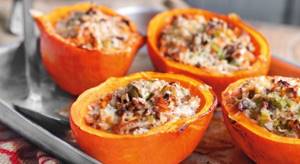
For example, you can make pumpkin the basis of the treat. It is filled with a hearty mixture of meat, cereals, and onions. For example, you can use beef or chicken for the filling.
Composition of ingredients
For the dish you need to take:
- pumpkin - half a kilo;
- meat – 280-300 g;
- rice - 1 tbsp.;
- onion – 1 pc.;
- salt.
Step-by-step cooking process
The cooking process includes several stages:
- The washed and dried meat should be dried. Afterwards, chop into pieces and process in a meat grinder with a grid with small holes. At this stage, it is possible to grind both raw and cooked meat. In the second case, it will need to be boiled in a pan of water or steamed. You can also simmer it with water in a frying pan.
- Rice should be boiled until soft and completely cooked. Peeled onion - chop.
- Then you need to once again process all the prepared products together with a meat grinder or in a blender bowl.
- You need to add salt to taste. When the mixture has cooled, add raw eggs to the mixture. Be sure to mix it very thoroughly.
- The pumpkin must be cut into 2 parts. From each it is necessary to remove the pulp and seeds.
- The indentations of the vegetable will be filled with meat filling.
Cook the dish in a steamer basket or on a wire rack over a large saucepan. You need to do this until the pumpkin softens.
How to serve a dish
Sauces can be served separately. For example, tomato or sour cream.
What to do if you have a stomach problem?
On a note
Proper balanced nutrition is one of the key elements in the prevention and treatment of gastrointestinal diseases.
A diet for stomach disease is prescribed by a doctor. After an examination and conversation with the patient, the doctor determines the range of permitted and prohibited foods, gives recommendations on heat treatment and the number of meals. Under no circumstances should you self-medicate. To speed up recovery from a sick stomach and intestines, it is important to adhere to proper nutrition.
Peach pudding
This recipe will make a healthy and delicious dessert. It is advisable to take fresh peaches for him.
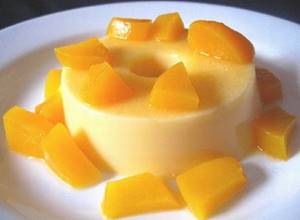
White almonds and vanillin will also be used to brighten the taste.
Composition of ingredients
For the dish you need to take:
- butter and flour - 100 g each;
- sugar – 330-350 g;
- eggs – 6 pcs.;
- fresh peaches – half a kilo;
- white almonds (ground) and crackers – 45-50 g each;
- milk – 280-300 ml;
- salt, vanillin.
Step-by-step cooking process
The cooking process includes several stages:
- Milk with butter, vanilla and salt should be placed in a saucepan, stirred, and brought to a boil over heat.
- Add flour to the bubbling mixture, stirring constantly.
- The finished mass must be cooled, add egg yolks and sugar (100 g). Again, mix everything.
- You will need to beat the egg whites with 60 g of sugar until stiff foam.
- You will need to place half the mixture into an oiled pan, sprinkle with ground nuts, crackers, and cover with slices of peaches.
- You need to put the remaining mass on top.
- Steamed or oven-baked, the treat will take about 40-45 minutes.
To make the sauce, make syrup from water and remaining sugar. You should also add a little peach puree to it.
How to serve a dish
The pudding should be served chilled. And pour sauce on top.
Menu for diet
To ensure that nutrition for gastrointestinal diseases is correct and harmless, you should think through your menu in advance. It is convenient to prepare it for several days at once. Below in the article several menu options are published. These are three meals each - breakfast, lunch and dinner.
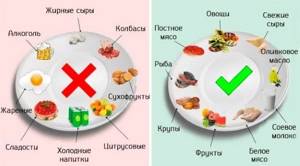
1 day:
- steamed omelette and herbal tea;
- creamy fish soup with toasted white bread;
- pork balls with assorted stewed vegetables.
Day 2:
- oatmeal porridge with milk diluted with water, baked apple;
- creamy beef soup with day-old white buns;
- zucchini-apple pudding, low-fat kefir.
Day 3:
- rice roll with fruit, toasted sandwich with curd cheese, tea;
- sea bass cutlets with mashed potatoes;
- meat zrazy with omelet and sliced fresh cucumbers.
Weekly menu for intestinal diseases
The weekly menu for intestinal diseases is selected based on the principle of maximizing the reduction of all negative consequences associated with food consumption. This allows the digestive organs to recover and establish full functioning. A week of nutrition following diet number 4 significantly reduces all manifestations and exacerbations of chronic gastrointestinal diseases.
If you take the daily norm during a diet, then the indicators should vary within the following limits:
- the total calorie content of foods consumed per day should not exceed 2100 kcal;
- the number of meals should not be less than 5 per day;
- portions should be small in size - for more efficient and simplified functioning of the intestines and stomach.
Diet table No. 4, designed for a weekly duration, is described in the table:
| Day of the week | 1st meal | 2nd meal | 3rd meal | 4th meal | 5th meal |
| Monday | Rice porridge made from round rice, low-fat steamed fish | Applesauce | Chicken broth with breast meat, dried fruit compote | Bagels or crackers without additives, green tea | Kefir, crackers |
| Tuesday | Oatmeal on water, steamed omelette | Soft curd mass, without additives, tea | Vegetable soup with rice or buckwheat, salad of boiled vegetables, tea | Tea or compote, dry cookies or non-yeast baked goods | Cookies, tea, a small amount of cottage cheese |
| Wednesday | Mashed potatoes with water, pate, tea and cookies | Cottage cheese casserole or manna, tea or jelly | Vegetable and lean meat soup, buckwheat porridge with chicken soufflé, non-acidic juice | Tea or juice, unsweetened waffles or unfilled cookies | Kefir |
| Thursday | Buckwheat porridge, a piece of chicken breast, tea or herbal decoction | Kefir, stewed vegetables, a slice of dried bread | Soup with meat and cereals, mashed potatoes with steamed cutlets, tea | Kefir or herbal decoction, cottage cheese casserole | Drying, kefir |
| Friday | Semolina porridge with apple, slice of bread | Steamed fish cutlets, vegetable stew | Lean meat soup with potatoes and rice, buckwheat porridge with chicken cutlets | Fruit puree, non-acidic juice, cookies | Cookies with tea |
| Saturday | Hercules on water with slices of chicken fillet, a slice of bread, tea | Fruit or vegetable puree, manna | Cream soup of pureed vegetables with croutons, noodles and stewed pork | Cottage cheese with fruit, tea and waffles | Kefir, tea and curd mass |
| Sunday | Semolina porridge, curd pudding, apple and tea | Dry cookies, fruit puree, jelly | Fish soup, puree, lean fish or meatballs | Omelette, cookies and tea | Tea, jelly and fruit puree |
Useful tips
If the housewife does not have a multicooker/steamer in stock, you can organize such a device using improvised means. To do this, you need to place a pan of water on the stove, and place a colander or pressure cooker on top. Various options for dishes with holes are suitable. It is steaming that will preserve the maximum of nutrients in products and make them harmless to the stomach and intestines. When preparing dietary dishes in the presence of gastrointestinal diseases, it is worth leaving a minimum of fresh vegetables and fruits in them. It is best to subject them to light heat treatment.
What foods should you eat when dieting and which foods are harmful to your health?
The diet for treating the stomach must be strictly balanced. Therapeutic nutrition has a positive effect on the manifestations of the disease, metabolic disorders, and affected digestive organs. The following products cannot be included in the menu:
- vegetables with rough cell walls, such as turnips or radishes;
- bread made with wholemeal flour;
- products with coarse connective tissues: stringy meat, poultry skin, fish skin or cartilage;
- unripe berries or fruits with a rough skin: grapes or dates.
During the acute stage of the disease, it is recommended to eat foods that practically do not irritate the gastric mucosa. Effective treatment directly depends on the patient's nutrition. If the patient eats warm and enveloping food, he will recover quickly. Dishes must be liquid or pureed. It is important that their consistency is easily absorbed by the body. Avoid using various seasonings. Eat more protein, which will help quickly restore damaged cells in the stomach mucosa. The patient needs to include the following foods in the diet:
- yesterday's bread;
- vegetables and fruits, boiled or stewed;
- drinks: jelly and compotes;
- jelly;
- soups without frying;
- omelettes;
- boiled meat and fish;
- porridges and milk soups;
- steamed cutlets;
- rosehip decoction;
- cocoa;
- tea and coffee with milk;
- mousse and marshmallow.
Increase the number of meals. If you previously only had lunch during the day, now increase the number of meals to 6. You need to limit the amount of table salt. In order not to oversalt your food, it is recommended to salt the food before direct consumption. The energy value of products varies from 1800 kcal to 2900 kcal. It is recommended to take vitamins, minerals and essential nutrients. It is advisable to replace sugar.
You can add lemon to weak tea. Baked side dishes are healthy. Dairy products should be consumed with reduced fat content. Treatment with herbs and propolis should be carried out under the supervision of a doctor. Traditional medicine also offers us effective infusions. Unpleasant symptoms are quickly eliminated if the correct diagnosis is made and proper treatment is prescribed. Support yourself with a diet and strictly follow all doctor's instructions. Play sports or exercise therapy!





